If you’ve been thinking about raising goats, you’ve probably wondered whether they need shelter. The short answer is yes. However, the type of shelter your goats will require can vary depending on several factors, including the season, your geographic location, management practices, and the size of your herd.
In this blog, I’ll dive into the topic of goat shelters, covering the essential requirements for any goat shelter to reviewing options from barns to portable enclosures to natural shelters. I’ll also share insights from my own experience raising goats on my farm.
Do goats need shelter?
Yes, in short, goats do need shelter. They need some shelter to cover them from rain, wind, sun, and other extreme weather conditions. As compared to other livestock, such as sheep or cattle, goats seem to have a lower tolerance for being wet. But, that doesn’t mean they can’t handle some wet weather and conditions.
So does this mean goats need a formal enclosure or barn? No, not at all. In fact, natural shelter can work too based on seasonal conditions and where you’re keeping your goats. Even modifying an old shed or structure can work just fine for housing for goats.
The type of goat shelter needed is based on seasonal needs. What’s needed in the winter is going to be different than the summer, as well as if you’re located in a more arid region your shelter needs will be impacted by your seasonal conditions as well as accessibility to feed such as pasture.
Goat enclosures can range from a kit you build, a pre-made shed you buy, a custom barn contracted with a local builder, repurposing an old shed or structure, or a full-out DYI project build.
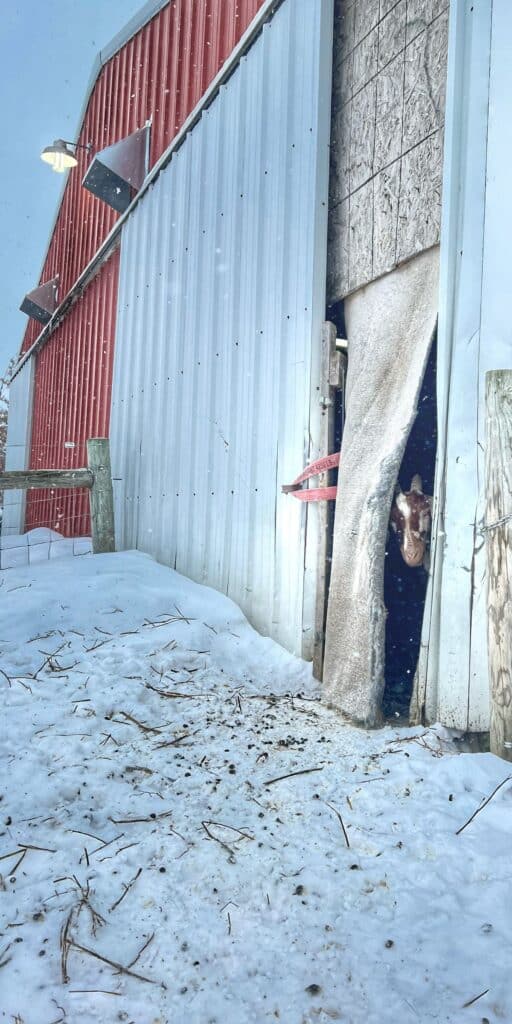
Different types of goat enclosures
There are several different types of goat enclosures:
- Barns
- Shed
- Portable
Basic requirements for a goat shelter
No matter the type of shelter, there are several basic requirements that need to be met for goat housing:
- Provides adequate protection from extreme weather conditions, such as heavy rain, snow storms, cold winters, or even shade from high temps. It will provide shade and serve as a wind block.
- Keeps goats dry. Access to a dry area will help minimize hoof and other health issues for your goats. The location of your shelter should be in an area where it stays fairly dry or where bedding can be added to keep the area dry. This doesn’t mean your goats can’t get wet, but they need to have the ability to get out of heavy rain, especially when it is cold.
- Access to feed and water. This may not necessarily be located inside the shelter, barn, or enclosure, but it will need to be nearby.
In most cases, a simple three-sided shelter usually will suffice. Depending on the season, the type of cover a shelter provides may vary depending on typical conditions where your goats and shelter are located. Less may be needed in the summer as compared to winter or even if you’re in a mild climate.
What about heat in the winter? No, goats do not need heat in the winter. In fact, if heat is provided in the barn it may actually interfere with how the animal is able to naturally adapt its body to seasonal temperature changes. For example, heat or even using a jacket can lead to goats not growing a full winter coat, which is part of their natural ability to adapt to their environment, including maintaining body heat. Learn more about raising goats in the winter in this article.
Shelters for different seasons
Requirements for shelters or enclosures for your goats will vary depending on the seasonal weather in your area. It’s best to take this into consideration for your specific context for your farm, weather, and seasonal patterns. How you manage your herd will also impact how shelter is provided.
In the summer, with the exception of extreme heat goats tend to need more formal shelter, such as a barn or three-sided shed. Natural cover such as brush or trees may suffice, or even an old hay wagon running gear with a wood deck can be enough to provide shade and enough cover from the rain.
If your herd is grazing away from the barn or a remote location, portable goat shelters that are mobile are a great option if there isn’t enough brush or tree canopy for cover.
In the wintertime, a three-sided shelter with the ability to keep animals dry and out of the wind is important.
Goat barn plans
Whether you’re looking to build, modify, or purchase a goat barn or do a DIY shelter, there are several factors you’ll have to consider when making plans:
- Will you just be housing your goats? Or, will you also store supplies and feed, such as hay?
- Where will you feed your goats? Inside the barn or outside?
- Where will your goats access water? Inside or outside?
- How many goats will you house in the barn? Are you growing your herd? Will they have access to a yard outside, or pasture?
- How do you plan to clean your shelter? Is there easy access for a small tractor? Or, can you take down pen walls for easier access to scrape bedding.
- Will it be portable or permanent?
- Will you have different shelters for summer and winter, or use the same enclosure?
- How will you use the barn throughout the entire year? Think about major management differences, such as winter vs. summer vs. kidding season.
- Will there be/is there enough ventilation for airflow throughout the entire year? You’ll need to make sure there’s good ventilation to avoid any respiratory issues, especially in the winter, but also airflow during the heat of summer.
All of these factors will influence how you decide to create plans for your goat barn, shed, or shelter.
Your space per goat for the barn is one of the most important factors to take into consideration. If you’re growing your herd, you’ll want to make sure you have room to accommodate more animals in the future, or easily expand the pen space in your barn or outside yard.
Generally speaking in a bedded pen, about 15-20 square feet is needed for does, while a bit more is needed, 25+ square feet for does with kids. Learn more about goat pen size guidelines for different settings and management practices in this article.
Additionally, if your goat barn or shelter has access to a larger outside yard or pasture. Your requirements for space per goat can be smaller since the goats will have regular access to other areas outside of the barn. This is also true for portable goat shelters used on pasture, where animals are in a rotational grazing system and have access to a paddock in the pasture and move frequently.
It’s okay to just have a goat shelter or barn that is just housing your animals. That keeps things very simple. Supplies and feed can go elsewhere so you can have a dedicated space for your animals and room to grow for pen sizes.
Over time you’ll find the best setup that works for your goat herd and the seasonality of your farm.
Personally, with our farm, we ended up taking down pen walls in our main barn. I found it easier to have a simple goat shelter with movable pen walls so we can have large group pens for most of the year when we are using the goat barn. Goats are herd animals and do better in groups instead of their own stalls or pens.
Additionally, then I can rearrange the setup in the barn once kidding season comes around to set up kidding jugs or stalls. We can move out the pen gates, and then easily clean everything after. Flexibility has been key for us.
You can find goat barn pen plans here.
Different goat shelter ideas
Next, we’ll cover a variety of different goat shelter options to give you ideas of what might work with your farm and the needs of your goat herd.
Barns
A traditional barn can be used for goats, whether you’re building a new one or using an existing structure and modifying it for use with your goats.
I live in Wisconsin, which historically has had hundreds of dairy farms scattered throughout the countryside. Now, many of those old stanchion barns are no longer in use. I know many farmers who have modified those barns in a cost-effective way into housing for goats and sheep. Often it includes taking out the old stanchions and/or putting up cattle panels.
Sheds
While barns and sheds are fairly interchangeable as terms, generally speaking, sheds are often three-sided buildings with the opening facing the direction where the least amount of wind comes from on your farm throughout the year. Old sheds can be converted into goat shelters with just a little bit of modifications.
Portable shelters
Portable goat shelters are a great option if your herd grazes throughout the growing season, does brush management work, or you want flexibility on their location on your farm.
Portable shelters are often on skids or have wheels so they can be pulled easily with a UTV or ATV. If they’re too lightweight, the shelter runs the risk of being blown away.
We’ve built portable hut-style shelters for our grazing season and pull them with our gator. I’ve also considered using old hay racks with just the wooden decking for a summer portable shelter as well.
Even small three-sided sheds can be mounted on skids and relocated to a different location in a small pasture to avoid regular build up of bedding and compaction in the area of the shed.
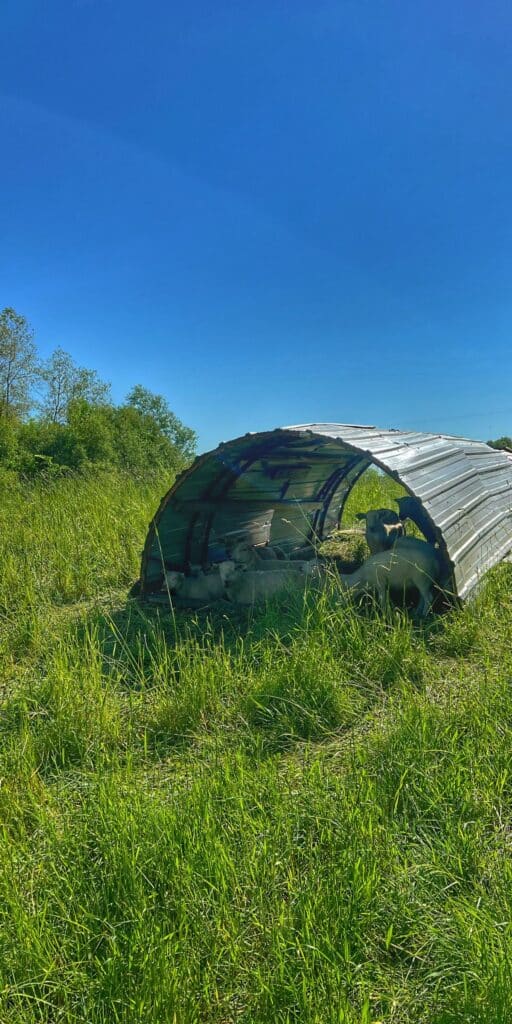
Goat hutch
Goat hutches are smaller structures where goats can get out of the elements. Often it could be a calf hutch, which were designed for young dairy calves either for a single animal or a group. Either size hutch will often accommodate several goats since they’re smaller in size than a calf.
Other goat hutch ideas include a port-a-hut, which is a low metal hut-style building. Port-a-hut is a specific brand, but you can even make these DIY style with old large culverts or even old hay feeder rings cut in half with sheet metal over the top. We use this last approach with our summer pasture shelters.
Plastic goat shelters can be also fashioned into a hutch from old plastic totes. Be sure to clean them out well, then cut a hole in the side for a door.
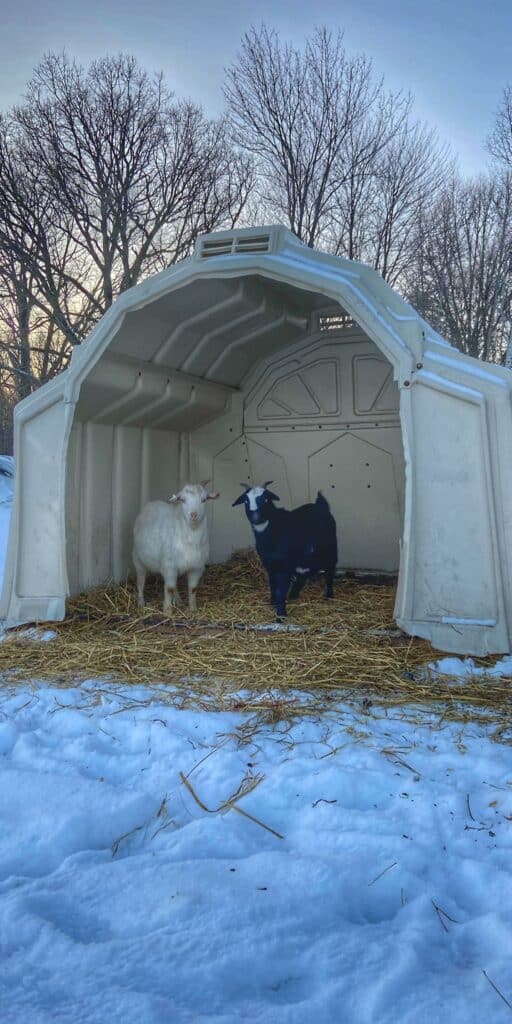
Natural shelter
While natural shelter options have been already mentioned, it’s worth mentioning them again in this section. Depending on the season and location, thick tree canopy or brush can serve as adequate shelter for cover from the elements for goats.
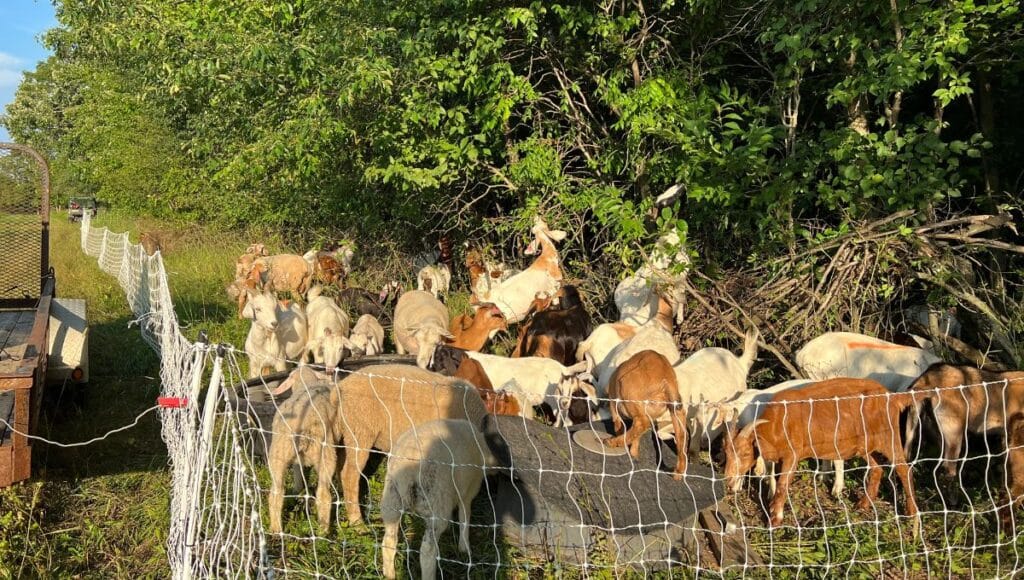
Goat shelter on our farm
On our goat farm we use a variety of shelter options with our goats and sheep.
During the winter our herd of does have access to the main barn for cover from extreme weather. However, we feed them outside with round bale feeders (also called bale grazing), and provide access to water as well. This approach helps keep our barn cleaner, more room for our goats and sheep to move and lounge around in the barn, as well as take advantage of the soil health benefits of feeding outside on pasture in the winter.
Our market goats in the winter live on pasture with access to a large three sided goat hut for cover from the elements. They also have access to feed and water outside like our other herd. You can learn more about how we prepare for raising goats in the winter in this article.
During the summer while our goats are rotationally grazing our pasture, they have portable shelters we pull through for them to use. We have metal huts we built and calf hutches on skids.
In areas where we have more cover with trees and brush, we don’t use any formal shelter since the natural canopy provides enough shelter for their summertime needs.
Related blog posts:
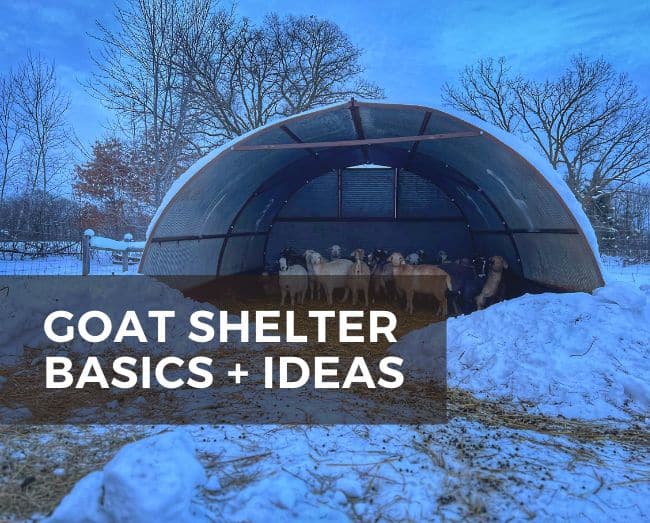
LEAVE A COMMENT
Comments